How Ravu Russian stormed. Part of 1
We previously characterized the general structure of the Battle of Galicia - during which the concentric offensive of the two groups of armies of the Southwestern Front at the first stage led to the autonomous Lublin-Kholmskaya and Galich-Lviv operations, which were then connected by the Gorodok operation. As part of the last and the battle unfolded at Rava Russian.
The main blow of the Russians was marked by the 3 and 8 armies against Lviv (the 4 and 5 armies advanced on Przemysl to Lviv). The plan of the Russians at the first stage of the battle is to reach the enemy’s flanks and defeat the latter in the Lvov area. In the first stage of the Battle of Galicia, the South-Western Front planned to crush the enemy’s flanks, cutting off its main forces from the r. San and Dniester, and destroy.
The fact that the Austrians carried the deployment of their armies on 100 km to the west, led to the fact that now the Austrian troops were hanging over the Russian northern flank.
On the southern flank of the enemy’s strategic formation, the main force was the Austrian 3 Army R. von Broderman.
She was opposed by the Russian 3-I army of N. V. Ruzsky.
The southernmost flank of the South-Western Front was the Proskurov group of troops, transformed into the 8 Army. The 8 Army was opposed by the army group Kevess von Kevessgaz. The arrival of the reinforcement of the last Austrian 2 Army was expected from the Balkan Front. The enemy hoped to hold out in Galicia until his main forces smashed the northern flank of the Southwestern Front.
At the beginning of the Battle of Galicia east of Lviv, the Russian 22 infantry divisions of the 3 and 8 armies met with the 15 divisions of the Austrians (3 army and the Kevess group). A significant number of troops arrived already in the course of the operation, influencing its drawing. The number of arriving reinforcements of opponents on the southern face of the Galician Battle was as follows:
Austrians:
in the 3rd army of R. Bruderman - 68 thousand people;
in the army group of Kevess (including the 2nd army of E. Bem Ermoli) - 130 thousand people.
Russian:
in the 3rd army of N. V. Ruzsky - about 6 thousand people;
in the 8th army of A. A. Brusilov - up to 62 thousand people.
The Austrians did not allocate enough forces to the southern flank - and the 3 Army with the group of Kevess could not become a solid shield on the path of the invasion of Russian 3 and 8 armies into Galicia. The 2 Army, which was delayed in concentration and introduced in parts, did not create a serious reinforcement.
The strategic importance of the Galich-Lviv operation (in which the Russian 3-I army played a crucial role) in the fact that this operation of the Russian troops seriously changed the situation in Galicia. An attempt by the enemy to cover the right flank of its strike force in Poland failed. And the victorious 3-I and 8-I armies went to the rear of the Austrian 1-th and 4-th armies (who had some success in the Lublin-Kholm operation), threatening them with defeat.
The failure on the south flank and the lack of results on the north forced F. Conrad von Gettsendorf to castling, shifting the center of gravity of combat efforts to the south. He wanted to concentrate the necessary forces in the area of Rava-Russkaya in order to secure the rear of the troops of M. Auffenberg (Austrian 4 Army). The last troops in the bulk (“maneuverable group”) shifted to the Lvov direction, leaving the “pursuit group” of the Russian 5 Army in the north. Konrad planned 3 armies (2, 3 and 4) to defeat the Russians 3 and 8, leaving a barrier in the north. Now, in the north, 28-Russian Russian divisions were opposed by Austrian 19, and on the contrary, the Austrians assembled 30 divisions against 22 Russians in the Lviv direction. Gorodok operation began.
The concentric offensive of the three armies of the Austrians in the Lvov area was to crush the left flank of the front - and now the main thing was for whom success would come faster: for the Russians in the north or the Austrians in the south.
Russian infantry offensive in Galicia, August 1914. Great struggle of nations. Issue 4. M., 1915.
By the beginning of the Gorodok operation, the troops of the opponents suffered serious losses (for example, the Austrian 4 army lost a quarter of its personnel), but, on the other hand, second-level connections and reserves were tightened. The delay of the 2 Army, which was solving the main task on the 3 of the day, was a very negative factor for the Austrians - it accounted for a third of all forces of the enemy-centered grouping. And the Russian armies of the northern flank launched an offensive earlier. 3-th and 8-th armies in the battles of Rava Russian - Town had to hold out.
The ratio of the forces of the opponents in the operation of Rava Ruska.
Austrians.
4th Army and part of the forces of the 3rd Army: 2nd (4th, 25th Infantry, 13th Landwehr Infantry Divisions), 6th (15th, 27th Infantry, 39th Honved infantry divisions), 9th (10th infantry and 26th infantry divisions), 17th (19th infantry division); 14th (3rd and 8th infantry divisions), 3rd (6th, 28th infantry, 22nd landwehr infantry divisions) army corps; 23rd and 41st infantry divisions; 6th and 10th Cavalry Divisions.
The Russians.
3rd Army with attached 12th Army Corps: 21st (33rd, 44th, 69th Infantry Divisions), 11th (11th, 32nd, 78th Infantry Divisions), 9th (5th, 42nd, 58th Infantry Divisions), 10th (9th, 31st, 60th Infantry Divisions), 12th (12th, 19th, 65th infantry divisions, 3rd rifle brigade) army corps; 11th, 9th, 10th cavalry, 3rd Caucasian Cossack divisions.
Before the battle at Rava Russian, the Austrians strengthened the 4 army with 3 marching brigades, the 3 army with 6 marching brigades. Opponents possessed approximately equal numbers of troops and artillery, but the Austrians relied on the fortified area. On the side of the latter there was also an advantage in delivering the first strike after a successful counter-maneuver.
The operation of the 3 Army of the South-Western Front near Rava Ruska took place in a difficult operational and tactical situation. After the capture of Lviv, the following tasks were assigned to its troops: August 23 to reach the line Varenzh-Belz-Dobrosin-Janow-Stradch; 24 August line Zherniki-Unuv-Rava Russkaya-Szherzhets; 25 August line Tomashev-Nemirov. The 9 Cavalry Division was ordered to act before the front of the 21 Corps, the 11 Cavalry Division after the capture of Rava Russkaya to go to the Lyubachev region, and the 3 Caucasian Cossack Division to move to the Nemirova-Krakovets area.
According to the directive of the front command of the 3 Army, it was necessary to attack Lashchov - Ravu-Russkaya, leaving the rear of the enemy who was operating in the Tomashevsky district against the troops of the 5 Army. This maneuver was also supposed to lead to a bypass of the Gorodok position from the north. In order to implement the latter task, the 3 corps of the 12 army was temporarily included in the 8 army. The unit was sent to the Yanuva area so that, by covering the left flank of the 3 army, it would help the 8 offensive.
In fact, the 3 Army began a dual operational task: to establish strong contact with the 5 Army, covering the city position. The consequence of this was the dispersion of the army corps with a fan at the front to 100 km. After the transfer of the 12 corps of the 3 Army, the 8 Army was supposed to cover the neighbor’s maneuver.
On August 22-23, the troops of the 3 Army were moved to their original positions before the start of the operation.
The central section of the Gorodok operation, which included the battle of Rava Ruska. White A. Galicia battle. M.-L., 1929.
On August 23 they occupied the following positions: The 21 Army Corps - Varenzh-Vyzhuv-Belz; 11 Army Corps - Butyni-Przhistan-Zametek; 9 Army Corps - Dobrosin-Kunin-Krehov and 10 Army Corps - Waldorf-Maidan-Dobrovice. The 9 Cavalry Division, being on the right flank, conducted reconnaissance on the Hrubieshov-Tyshovtsy. The 11 Cavalry Division from Buda acted on Ravu-Ruska, and the 3 I Caucasian Cossack conducted reconnaissance on Nemirov.
The enemy on 23 August had the following disposition.
The 4 Army I reached the Rava Russkaya (17 Army Corps) line - Art. Whole (6 st army corps) - Nemirov (9 st army corps). 3-I army held a fortified position on the river. Vereshchitsa - on the line of Gorodok ponds and heights between Yavorov and Kamennobrod. Part of its corps interacted with parts of the 4 Army: The 3 Army Corps (6, 28 Infantry, 22 Landward Infantry Division) occupied positions with Cherlani - Gorodok - Turkenbukel height, to the left flank before Yavorov was 23 th I drove infantry division.
The Austrian plan assumed, advancing 3 armies from r. Vereshchitsa, cover the flanks of the Russian 3 and 8 th armies as they move to the Gorodok position. The Austrian armies were advancing: 4-I - north of Veržbljany - Lelehovka - Rzensna Polska; 2 is south of Solonka M - Navariya - Cherlan (10 km southwest of Lviv) and 3 is between the 2 and 4. The Austrian 4 Army was to forge the Russian 3, and the Austrian 2 and 3 armies, striking the left flank of the Russians, threw them to the north.
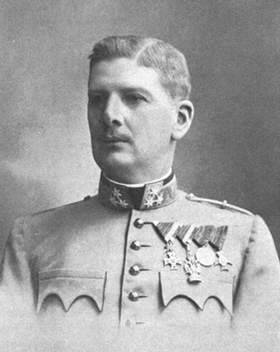
Commander of the Austrian 3 Army, cavalry general R. Von Broderman.
The commander of the Austrian 4 Army General of the infantry M. von Auffenberg.
The Russian 3-th army of the main forces (9-th, 10-th and 11-th army corps) moved to the Ravu Russkaya - to the north-west of Lviv. The army command believed that the enemy was in a state of retreat. In fact, the Austrian 3 Army, the northern wing of Cann, which was conceived by F. Conrad Gettsendorf, was advancing on the corps of the 4 Army from the north. The Austrian 3 Army strengthened significantly — the transfer of the 2 Army ended. Opponent proceeded to action.
On August 23 The 9 Army Corps of the Russian 3 Army was guided by the vanguard of the 11 Army Infantry Division in the village of Przhistan. In the evening, attacking Ravu Russkaya along the highway, he held positions on the front of Dobroshin-Kunin-Krekhov. Corps cavalry in with. Dobrosin conducted a successful battle with squadrons of the Austrian 6 Cavalry Division.
The Russian cavalry acted actively on that day - the 21 Cavalry Division advancing on the right flank of the 9 Corps in the vicinity of the latter defeated the rear of the Austrian 14 Corps (captured prisoners from the 14 howitzer division and 30 charging boxes).
The Russian 11 Cavalry Division, supported by the 176 Infantry Regiment, began a battle with a brigade of the Austrian 19 Infantry Division - to the west of Buda.
The 10 corps was located in the Waldorf-Dombrovica region, and the 12 corps was in the Janów-Stradzi-Kozice region. 21-th Army Corps began crossing over the river. Solokiya, reaching the region of Varenzh-Belz, and the 11-th corps advanced to Butyni-Lubela. The cavalry carried out reconnaissance and cover of its troops: the 9-I cavalry division at Lubów-Tyshovice-Hrubieszhov; 11-I cavalry division on Krzybe-Tomashev, 3-I Caucasian Cossack division at Janów-Nemirov.
On August 24, the main forces of the Russian 3 Army continued to attack the Russian Rava. At this point, the Austrian 4-I army struck at its right flank. The Russian 9 and 10 army corps near Rava Ruska faced three corps (6, 9, 17 army) M. Auffenberg.
The 9 Corps was attacked by the 17 Army Corps and the 41 Corps of the enemy's infantry division from the Rava Russkaya-Magiruva. He fought stubborn battles with enemy infantry units reinforced by 4 and 6 cavalry divisions.
The attacks of the enemy were repelled. In many ways, this was facilitated by the tactically competent activity of the corps commander - D. G. Shcherbachev. The latter recalled the difficult position of the 9 corps.
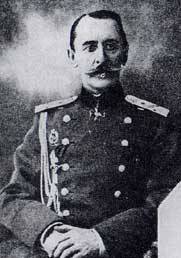
Lieutenant-General D. G. Shcherbachev.
The 10 Corps, attacking Magiruv, was attacked by the Austrian 6 Corps and part of the forces of the 41 Fifth Division.
The 21 body was moving on Stepyatyn-Dolgobychev, the 11 body was advancing on Unuv, the 9 body was working for Ravu, and the 10 body was slightly further south. The 12 Corps was left in the Janow area.
The offensive of the Austrian 4 Army led to a series of stubborn oncoming battles.
Opposing opponents led to breakthroughs and rounds. So, when the regiments of the Russian 5 Infantry Division, knocking over parts of the Austrian 19 Infantry Division, moved to the left bank of the r. The bourgeoisie, part of the Austrian 41 th drove division began to bypass their left flank. To counteract the bypass, the 2 Brigade of the 5 Division was sent to Pogorzhelisk to, in turn, deliver a flank attack to the bypass units of the enemy.
The order of the commander of the 9 Corps said: the 5 division to continue to attack the Russian Rava, the 58 division to advance to Monastyrek, and the 42 division (allocating the 1 brigade to the commander reserve) to strengthen the 58 division. The latter, having started a head-on at Stone Mountain with the 39 th Hoped Infantry Division, attempted to cover the right flank of the enemy. Moreover, the Austrians also began to cover the right flank of the 58 Infantry Division, cutting it off from the neighboring 5 Infantry Division. The 58 Division tried to attack twice - but was stopped by powerful fire. The enemy began to advance in the gap between the 58 and 5 infantry divisions, and in Pogorzhelisk pressed the left flank of the 2 brigade of the latter. When, around the 20-ti hours, units of the 58 Infantry Division again went on the offensive, they were met with a bayonet counterattack.
The alarming situation at the front of the 9 Corps led to the fact that the command of the 3 Army sent him to the aid of the 11 and 10 Army Corps. The 78 Division I occupied. Guiche, the 11 Division moved to the Zaborzhe region, and the 32 Division and 11 Division fought with units of the Austrian 3 Infantry and 2 Cavalry Division at Karuva-Zaborje. The divisions of the 10 Corps provided the left flank of the 9 Corps.
Attached to the 3 Army, the 12 Corps received the task of covering the left flank of the 3 Army, assisting the 8 Army when the enemy attacked from the Gorodok position. The 21 corps went up to the town of Radostav, where it fought off enemy attacks.
Продолжение следует ...
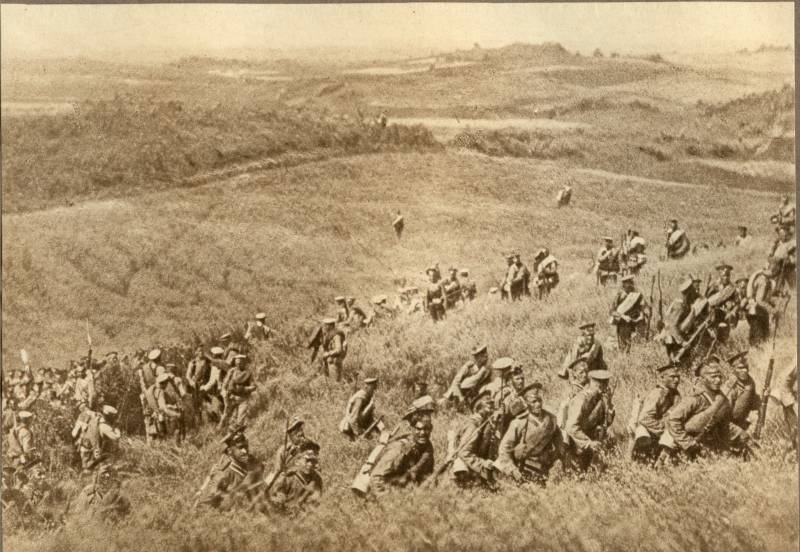
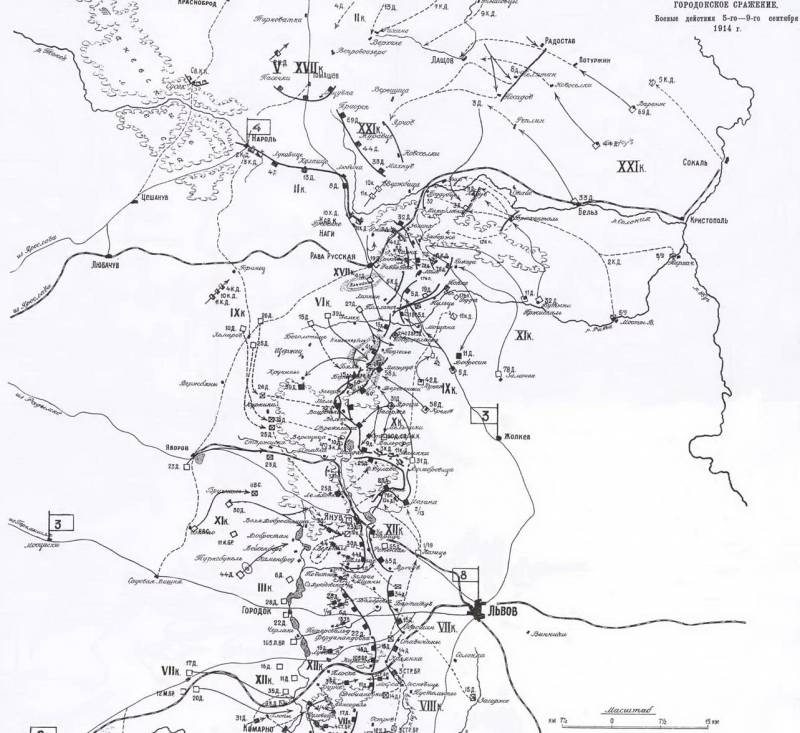
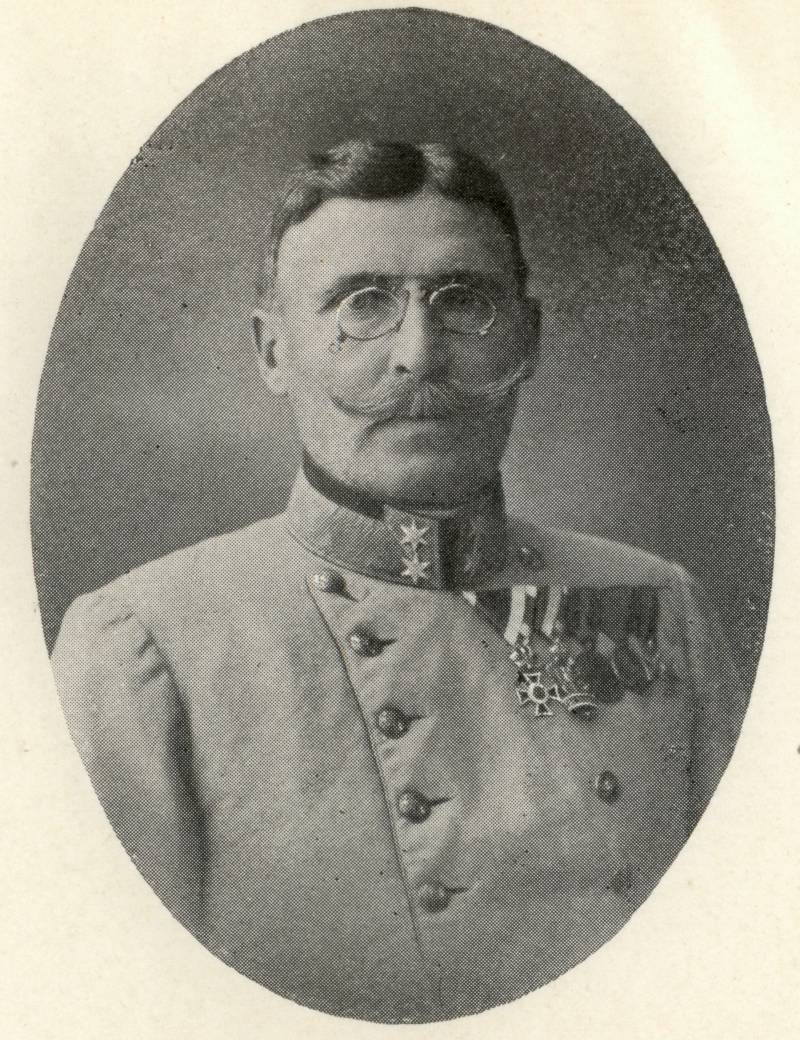
Information